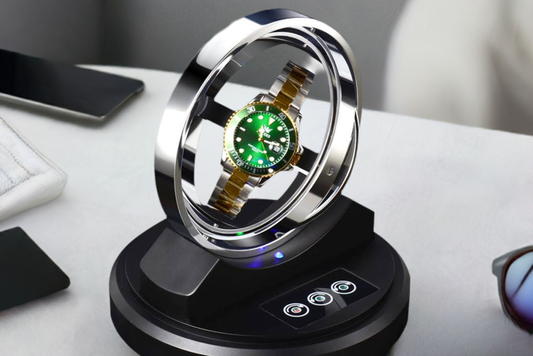Winding a manual watch is a crucial aspect of maintaining its precision and an art form in itself. In this comprehensive guide, we'll delve into the step-by-step process, answer common questions, and explore expert tips to ensure your mechanical timepiece stays in top condition.
Credit: YouTube Channel - Crown \u0026 Caliber by Hodinkee
Understanding the Stem and Crown
Locating the Stem
To begin winding a manual watch, locate the stem, typically found on the side of the watch at the 3 o'clock position. The stem is a small dial that protrudes from the case and is used to set the time and wind the watch.
Correct Position for Winding
Ensure the crown is fully extended from the case, engaging the winding mechanism. The crown is the knob at the end of the stem that you turn to wind the watch.
Step-by-Step Winding Process
Clockwise Winding Technique
Follow these steps to properly wind your manual watch:
- Gentle Twists: Hold the watch face up and turn the crown clockwise until you feel resistance, indicating the watch is fully wound.
- Avoid Overwinding: Stop when you meet a hard stop to prevent damage. Overwinding can stress the watch's gears and springs, leading to premature wear or breakage.
Setting the Watch After Winding
After winding, you may need to set the time or date:
- Changing Modes: Gently pull out the crown to set the time or date, if applicable, allowing you to adjust the watch's hands or calendar.
- Correct Time Setting: Set the time correctly, including AM/PM for non-24-hour dials, and account for daylight saving time (DST) if applicable.
Handle your watch with care, as it is a delicate piece of machinery. Avoid exposing it to extreme temperatures, shocks, or magnetic fields, which can affect its accuracy and longevity.
How Often to Wind?
The frequency of winding depends on various factors, including the watch's movement, usage, and personal preference.
Daily Winding
Winding your manual watch daily is recommended for consistent accuracy, ensuring the mainspring remains fully wound and provides a constant power source to the gear train.
Letting It Stop: Pros and Cons
There is an ongoing debate about the benefits of daily winding versus letting the watch run down. Some argue that daily winding can lead to excessive wear, while others believe letting the watch run down can cause lubricants to break down. Ultimately, the decision depends on individual preferences and the watch's specific requirements.
Winding Direction Matters
The direction in which you wind a manual watch is crucial, as it can affect the watch's accuracy and longevity.
Bidirectional vs. Unidirectional
Some manual watch movements allow winding in both directions (bidirectional), while others only permit winding in one direction (unidirectional). It's essential to wind your watch in the correct direction to avoid damaging the gears or mainspring.
Automatic vs. Manual Watches
The Difference
Automatic watches use a rotor to wind the mainspring as the wearer moves their arm, eliminating the need for manual winding. Manual watches require regular winding by the user to maintain their power reserve.
Winding an Automatic Watch Without a Rotor
In some cases, an automatic watch may require manual winding due to insufficient wearer activity. The watch can be wound manually using the crown, just like a traditional manual watch, to ensure accuracy and functionality.
Proper Care for the Crown
Avoid Water Exposure
Screw down the crown if water-resistant to maintain seals. For example, the Omega Seamaster Planet Ocean 600M ($6,500) has a water-resistance of up to 600 meters and features a screw-down crown. Always screw down the crown after adjusting the date or time to prevent water from entering the watch case.
Gentle Handling
Protect the crown from excessive force to prevent damage. The crown is a delicate part of the watch, and applying too much pressure can cause damage to the stem or the crown itself. Use gentle movements when adjusting the time or date. The Rolex Submariner ($8,100), a popular diver's watch, has a crown designed to withstand underwater pressure but still requires gentle handling.
Storing Your Manual Watch
Watch Winders
Watch winders keep your manual watch wound and ready to wear when you need it. They are particularly useful for watches with complex mechanisms or those not worn frequently. The Orbita Sparta Watch Winder ($295) is a popular choice, featuring a sleek design and the ability to wind up to three watches at once.
Ideal Conditions
When storing your manual watch, keep it in a cool, dry place away from direct sunlight. Avoid storing your watch in a humid environment, as moisture can seep into the watch case and cause damage. Store the watch in a protective case or box to prevent scratches and damage. For example, the Patek Philippe Calatrava ($20,000+), a luxury manual watch, should be stored in a cool, dry place to maintain its intricate mechanisms and prevent damage.
Possible Reasons for a Stuck or Hard-to-Wind Watch
When a manual watch becomes stuck or hard to wind, it can be due to several reasons:
- Lubrication Needs: Over time, lubricants inside the watch's mechanical components can break down, causing friction and resistance.
- Dirt Accumulation: Dirt, dust, and other contaminants can accumulate inside the watch's mechanical components, causing friction and resistance.
- Mechanical Issues: Worn or damaged gears, bearings, or other components can cause the watch to become stuck or hard to wind.
Professional Servicing
If your manual watch is stuck or hard to wind, seek the services of a professional watchmaker. A watchmaker can diagnose the issue and perform the necessary repairs or maintenance to get your watch running smoothly again.
- When to Seek a Watchmaker: If you've tried winding your watch and it's still not working properly, or if you're unsure of how to wind it correctly, seek the services of a professional watchmaker.
Attempting to force a stuck or hard-to-wind watch can cause further damage, so it's best to seek professional help if you're unsure of how to proceed. Regular maintenance and servicing can also help prevent these issues from occurring.
Conclusion
Mastering the art of winding a manual watch not only keeps time but also preserves the legacy of your timepiece. By following these detailed steps and insights, you'll ensure your mechanical watch remains a reliable companion for years to come. Wind with care, and your watch will reward you with precision and elegance. If you have any further questions or experiences to share, please leave a comment below. Don't forget to share this guide with your fellow watch enthusiasts!
FAQ
How do I know if my manual watch is fully wound?
When winding your manual watch, you will feel resistance once the mainspring is fully wound. At this point, stop winding to avoid overwinding and potential damage to the watch's internal mechanisms.
Can I overwind my manual watch?
Yes, it is possible to overwind a manual watch. Overwinding can cause damage to the mainspring and other internal components. To avoid this, stop winding when you feel resistance, indicating that the mainspring is fully wound.
How long will my manual watch run after being fully wound?
The running time of a fully wound manual watch depends on the specific model and its power reserve. Most manual watches have a power reserve of 36 to 48 hours, while some high-end models can last up to several days or even weeks.
Can I wind my manual watch while it's on my wrist?
It is generally not recommended to wind your manual watch while wearing it on your wrist. This can put unnecessary stress on the crown and stem, potentially leading to damage. It's best to take the watch off your wrist before winding it.




